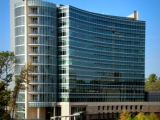Oct 14, 2009 (CIDRAP News) – Top state health officials said today they have been kept busy battling rumors and myths about the pandemic H1N1 vaccine, on top of the demanding work of coordinating the vaccination program just getting under way.
"We've been spending an inordinate amount of time lately saying the vaccine is made just like seasonal flu vaccine," said Tennessee Health Commissioner Susan Cooper, MSN, RN, during a public teleconference held by the National Biodefense Science Board (NBSB).
The board met by telephone today to hear state and local perspectives on the pandemic and discuss recommendations about behavioral health issues related to the pandemic, among other agenda items. The NBSB advises the secretary of the Department of Health and Human Services (HHS) on biodefense issues.
"There's this misperception that keeps getting heightened in the media that this vaccine was rushed to market, that corners were cut, that there's some special way this was made that's different from seasonal flu [vaccine]," Cooper said.
She said most people believe that Tennessee's health department is working to protect and improve the health of residents, "but then you get a talking head saying, 'Well, they're lying to you.' That then complicates the messaging."
Cooper said the news media in the state have been doing a good job of covering the story: "We've been fortunate in that we've not had some of the fear mongering that's going on about the vaccine. . . . But it's difficult when you can go to national media and find misinformation."
Mary Selecky, secretary of health in Washington state, told the board she has been dealing with misinformation too.
"We have a very interesting history in the Northwest that has to do with that frontier mentality," she said. "Glenn Beck [a conservative radio commentator] is from Washington state. My understanding is that perhaps Glenn Beck is not the best supporter of vaccines."
Noting a recent Harvard School of Public Health poll that showed only 50% of parents will allow their children to be vaccinated, she said, "We have a lot of work to do. There are a lot of difficult, confusing details to the public. . . . Then we're getting hit with the seasonal flu vaccine lack of availability, and it's just adding to the confusion."
Jay Butler, MD, of the Centers for Disease Control and Prevention (CDC), said a recent CDC survey on attitudes about the H1N1 vaccine showed a more positive response: 61% of respondents said they would definitely or probably get the vaccine if it becomes available to them. The poll involved about 500 people.
Patricia Quinlisk, MD, MPH, who chairs the NBSB and is also Iowa's state epidemiologist, agreed that misinformation is a challenge. "There's a lot of misinformation out there, and anything that can be done at the national level and with nongovernmental speakers would be really helpful," she said.
Vaccination drive going well
Despite many challenges, Cooper and Selecky reported that the H1N1 vaccination programs in their states are working well so far.
Cooper said more than 1,200 providers in Tennessee have preregistered with the health department stating their intent to give the vaccine, and the actual number of vaccination sites is higher because some of those that registered represented multiple sites, such as pharmacy chains. Selecky put the number of providers in Washington at more than 2,000.
"All of the investments made into preparedness planning for all types of disasters have really paid off," said Cooper. "In Tennessee our plan is really working, and we're ecstatic about that."
"We've ordered everything available to our state, and it's getting out to providers timely, not sitting on a dock somewhere," she added.
In Washington, said Selecky, "Vaccine is getting into healthcare workers, it's getting into children. . . . The train is moving down the track, and we're very proud of the work that we're doing." Healthcare workers are among the priority groups for the vaccine.
Selecky said the immunization program comes at a very tough time because of recent layoffs in public health. Local public health agencies in Washington have 330 fewer full-time equivalent jobs now than they had a year ago, she reported.
Public health will meet the challenge, but it will mean letting go of less urgent tasks, she added. "It's a time when public health will shine, but they're going to be very, very tired at the end of the day."
Mental health recommendations considered
The NBSB today also discussed a set of recommendations about mental health issues related to the H1N1 pandemic. After considerable discussion, the board asked its Disaster Mental Health Subcommittee to come up with a list of very specific guidance materials that HHS can send to state health departments and physicians soon.
The subcommittee had drawn up a set of recommendations and actionable next steps regarding intervention, training and education, communication and messaging, and vulnerable populations.
For example, the communication recommendations call for officials to integrate behavioral health factors into all health messaging, expand the use of nontraditional communication, address the needs of special populations, and "maintain sensitivity to terminology."
For actionable steps, the subcommittee advised public health communicators to discourage the use of the term "worried well" because it is "imprecise in the context of H1N1." Instead, public health messages should tell people why they should refrain from usual behavior, such as going to a hospital emergency department for flu-like symptoms, and tell them what to do instead, the proposed recommendations say.
In requesting specific advice from the subcommittee, Quinlisk said, "We want HHS to send to every state health department in the country this specific information, and this should be sent to every doctor in the state to present to their patients."
Betty Pfefferbaum, MD, JD, chair of the subcommittee, said she thought the panel could accomplish that.


















